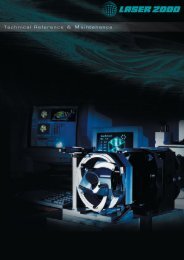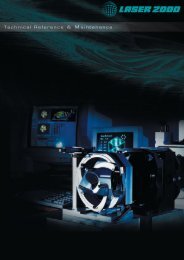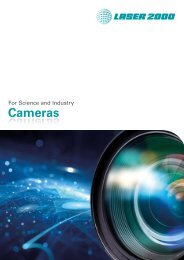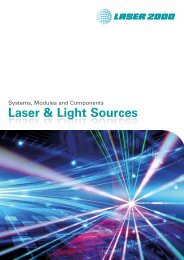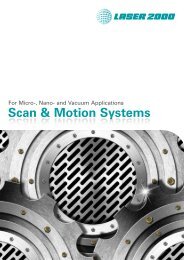Semrock Master Catalog 2018
Semrock Master Catalog 2018
Semrock Master Catalog 2018
You also want an ePaper? Increase the reach of your titles
YUMPU automatically turns print PDFs into web optimized ePapers that Google loves.
The Physics of Pixel Shift<br />
Pixel shift refers to the shift of a<br />
microscope image that can occur when<br />
switching between fluorescence filter<br />
cubes. This is undesirable because<br />
the individual images obtained with<br />
these cubes do not overlap precisely<br />
with each other, causing issues in the<br />
analysis and understanding of the<br />
image data. This white paper explains<br />
the optical physics behind pixel shift,<br />
and outlines some key considerations<br />
in the design of optical filter sets with<br />
“zero pixel shift” (less than one pixel<br />
error) performance.<br />
Pixel Shift in Fluorescence<br />
Microscopy<br />
Multicolor imaging in fluorescence<br />
microscopy is typically performed by<br />
acquiring sequential images at different<br />
emission wavelengths, and overlaying<br />
these images to study the spatial<br />
distribution of cellular components.<br />
Imaging artifacts such as “pixel shift”<br />
can compromise the extent to which<br />
such a composite image correctly<br />
represents the biological phenomena.<br />
This white paper discusses pixel shift<br />
in the context of multicolor imaging,<br />
how these shifts can be mitigated,<br />
and which types of multicolor<br />
imaging can be used to improve<br />
microscopy performance.<br />
Practical Aspects of<br />
Mirror Usage in Optical<br />
Systems for Biology<br />
Multimodal NLO Imaging<br />
Nonlinear optical (NLO) imaging is<br />
a powerful microscopy technique<br />
in the field of biomedical optics, in<br />
which ultrafast laser excitation is used<br />
to exploit several nonlinear optical<br />
effects that can provide high-contrast<br />
imaging of biological samples. This<br />
white paper discusses the emergence<br />
of NLO imaging and how it has been<br />
facilitated by advances in three key<br />
technology areas: ultrafast lasers;<br />
high-performance, hard-coated optical<br />
filters; and high-sensitivity detectors.<br />
Fluorophores commonly used in<br />
combination with NLO fluorescence<br />
imaging are also discussed.<br />
Understanding Polarization<br />
Despite its importance for many optical<br />
systems and applications, polarization<br />
is often considered a more esoteric<br />
property of light that is not so well<br />
understood. In this article our aim is to<br />
answer some basic questions about the<br />
polarization of light, including: what<br />
polarization is and how it is described,<br />
how it is controlled by optical<br />
components, and when it matters in<br />
optical systems.<br />
How to Calculate<br />
Luminosity, Dominant<br />
Wavelength, and<br />
Excitation Purity<br />
This article provides a brief overview<br />
of a simple, clear, and unambiguous<br />
method for calculating the color an<br />
observer sees when looking through<br />
an optical filter at a well-defined<br />
light source using the CIE 1931 Color<br />
Specification System.<br />
Measurement of<br />
Optical Filter Spectra<br />
Due to limitations of standard<br />
metrology techniques, the measured<br />
spectral characteristics of thin-film<br />
interference filters are frequently not<br />
determined accurately, especially<br />
when there are steep edges and<br />
deep blocking. Use of the optimal<br />
measurement approach for a given<br />
filter or application can reduce errors<br />
in and overdesign of experiments and<br />
systems that use filters, thus optimizing<br />
performance, results, and cost.<br />
NIR Filters Mirrors Polarizers<br />
Edge<br />
Filters<br />
Dichroic<br />
Beamsplitters<br />
Laser-line<br />
Filters<br />
Laser Diode<br />
Filters<br />
Why are so many different models<br />
of mirrors found in biological optics<br />
setups, and how does one know<br />
which mirror to purchase for a specific<br />
purpose? This paper seeks to<br />
answer those questions, by providing<br />
practical, useful information on the<br />
now ubiquitous flat dielectric mirror.<br />
It also outlines some of the key design<br />
considerations and specifications<br />
to consider when selecting the<br />
appropriate flat mirror for an optical<br />
system used in biology.<br />
Notch<br />
Filters<br />
Lamp Clean-up<br />
Filters<br />
111<br />
More




